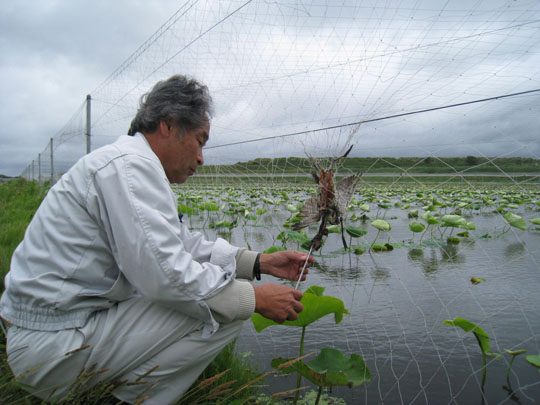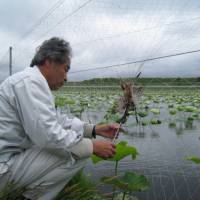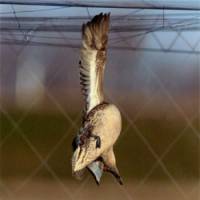Earlier this year it was reported that one of the 10 Crested ibises reintroduced to the wild on Sado Island last autumn had turned up in Fukushima Prefecture, in central Honshu. The islanders worried that Nipponia nippon, which had come to represent their Japan Sea home, had abandoned them.
Perhaps they should have been worried instead that the treasured, pink-faced bird with a long curved beak, appeared to be heading directly towards Lake Kasumigaura, the system of lakes and wetlands straddling the border of Ibaraki and Chiba prefectures, northeast of Tokyo.
Over the last five years, Kasumigaura — a natural haven for birds like the ibis that favor rivers, lakes and marshes as feeding grounds — has become a veritable avian killing fields due to the presence of giant nets laid over commercial lotus paddies on the lake's northern shores.
Ibaraki Prefecture, in which the majority of the lake is located, is Japan's biggest producer of lotus roots, with an annual output of 26,000 tons of the vegetable known as renkon in Japanese. Cultivation was established there after World War II, when the plants were introduced to cash in on their resistance to floods, which tend to swamp those shores every two or three years.
All was well until around 2000, when, as ecologist Seiichi Kasuga explained, the birds visiting Kasumigaura — including Common teals, Common snipes, Spot- billed ducks, Common coots and Little egrets — "began to venture into the lotus paddies, probably as a result of increased competition for food."
As Mikio Horikoshi, from the local branch of JA (Japan Agricultural Cooperatives), explained, "The birds eat the lotus leaves and reach down and nibble the roots too, rendering them unfit for sale." Between 10 and 20 percent of the total crop was being lost this way, he said.
Farmers tried scarecrows and sound- blasting machines to ward off the birds, but they soon got used to those. So, with JA's help, they acquired national government subsidies to cover half the cost of installing nets over the worst-affected paddies. The nets, set about 2 meters above the paddies, were introduced in 2004.
A 2005 report by the Ministry of Agriculture, Forestry and Fisheries justifies the nets as part of a plan to assist domestic lotus-root growers in the face of cheap Chinese imports.
But the nets had a deadly side effect. Hundreds of the birds they were supposed to be keeping away ended up getting caught in them and dying cradled or hanging in their deadly mesh. Next came birds of prey, such as Goshawks and Ural owls, which got caught as well when they tried to pick off the trapped fowl.
Over several days in spring, 2005, members of the Ibaraki branch of the Wild Bird Society of Japan (WBSJ) counted 329 dead birds in the areas immediately surrounding the lakes. A second count over several days in autumn 2005, found 679 dead birds.
Ecologist Kasuga, who studied the marine ecology of Kasumigaura for the National Institute for Environmental Studies until his retirement in 2001, has spent several years collating data on the birds caught in the nets.
"At first it used to upset me," he said, describing how he felt when he came across single nets with five or six dead birds in them. "Now I just try to work out how they got caught — whether they were caught coming in or trying to get out and, if so, how they got in," he explained. Many of the birds, Kasuga noted, simply walked under the nets from the side.
One afternoon recently, Kasuga took The Japan Times to fields just northeast of Tsuchiura Station, where there seemed to be at least one dead bird in every paddy. He measured and recorded the length of one bird trapped near the road. With its rib cage slightly visible, he reckoned it had died about a week before.
"This is a Whimbrel," he explained. "It's a wader and one of the rarer birds you see here."
In a count conducted by the WBSJ in January 2008, 1,173 birds were found dead in the nets. A year later, in January 2009, the society logged 1,255 victims.
Susumu Ikeno, head of the WBSJ's Ibaraki branch, explained that the number of deaths prompted their group to suggest to JA that they use different nets. "Nets are by no means the ideal solution, but we thought there was a chance it could help the situation," he said.
Late last year, JA began experimentally deploying new nets made of plastic instead of string, and with a smaller mesh 12-cm square instead of 16 cm.
"We believe the new nets have resulted in fewer bird deaths," JA's Horikoshi said, adding that JA hopes to replace all the old nets with these new ones next year — hopefully with national or prefectural government subsidies.
However, the WBSJ's Ikeno said he had not been told where the experimental nets have been deployed, so he couldn't judge their effectiveness for himself. Instead, he cautioned against the idea that the new nets would magically solve the problem.
"It is also necessary to change the farmers' way of thinking," he said. "They must be told to put netting on the sides of their paddies, so the birds can't get in under the nets."
At present, he explained, even when farmers do install side nets, they often neglect to close them after each day's work. "Not even new nets will help the situation unless the farmers use the nets properly," Ikeno stressed.
Local ecologist Kasuga went further still. "The nets are kept up all year round even though the majority of the birds are only here for short periods of time — in the spring and autumn months," he said.
"The farmers have also said that the most damage is done when the lotus roots are just sprouting new shoots," he added. "But that happens for just a few weeks from the end of April till early May."
He called for more research to be done to determine whether nets — of either the new or old type — are really the most effective way to protect the lotuses.
One of the problems for bird-lovers is that most of the birds being trapped — Common teals and Common coots — are, well, common.
"Even the deaths of two or three rarer birds, such as Goshawks, can be explained away as a accidents," Kasuga said. He laughed wryly when asked what would happen if — heaven forbid — a Nipponia nippon fell victim to a net. "That would get everyone's attention!"
The female Crested ibis that turned up in Fukushima has now been tracked back to Niigata Prefecture on the Sea of Japan coast, so for the moment it appears to be out of harm's way.
Sadly, the same cannot be said for the thousands of other birds that have and will continue to die along Lake Kasumigaura's shores.






















With your current subscription plan you can comment on stories. However, before writing your first comment, please create a display name in the Profile section of your subscriber account page.